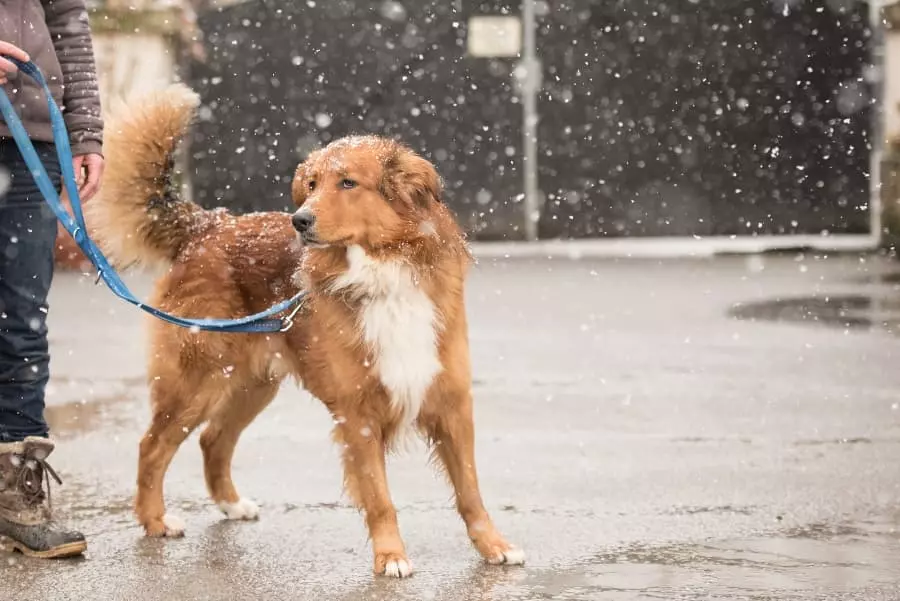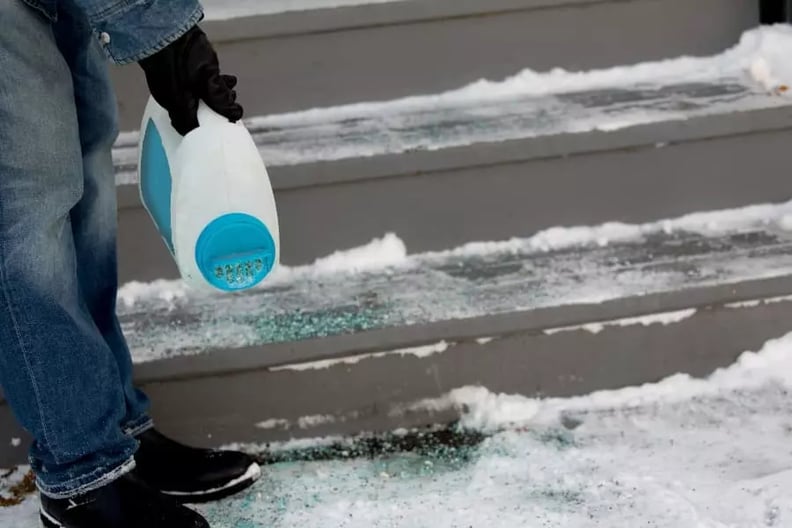
When the snow starts to fall the world quickly turns into a winter wonderland. Despite the pristine white beauty, hazards lurk that can harm your four-legged friend such as the chemical ice melter referred to as ice melt.
Winter officially starts in the Northern Hemisphere on December 21, but the weather usually starts to shift months beforehand with snow, ice, and sleet becoming familiar challenges to your pet's safety.
If you are wondering, is ice melt safe? The answer is 'no'. However, if you take the right precautions you can make sure your dog not only stays safe but can also enjoy his favourite outdoor activities when the temperature drops.
In this article, we will explore some common wintertime pet dangers and how you can keep your pup safe, such as dog boots and pet-safe ice melt options.
What is Pet Safe Ice Melt?

Winter can be a dangerous time of year for your fur friend. The road salts and ice melts we use to keep our streets and sidewalks free of ice and safe for us, are less than safe for pets. Ice melts work by melting ice (they are also used to melt snow) but they are not without dangers to pets.
The melter works to melt ice on the surface of asphalt so it's less slippery when the weather hits a freezing point. However, chemicals such as magnesium chloride and potassium chloride can burn your pet's paws after prolonged exposure without the protection of dog booties and prove toxic if ingested.
Types of Ice Melts & Pet Safe Ice Melts
When shopping for pet-safe ice melt, you'll encounter a lot of different brands and types of ice melt on the market. Some even proclaim themselves non-toxic and biodegradable. However, any melter ingested in large amounts can prove dangerous.
Classic Rock Salt
One of the most common is sodium chloride-based, which is basically rock salt that melts ice. The term ‘rock salt' is a bit misleading. It might sound safer but it's not. Exposure to rock salt can quickly irritate your dog's skin. It does take ingestion of a large amount of rock salt to cause a poisoning danger.
Ethylene Glycol-Based
Ethylene glycol-based ice melts are extremely dangerous. They contain the same active ingredient as antifreeze which is deadly when ingested. Even ingestion of a small amount by furry friends can rapidly cause kidney failure, gastrointestinal upset, stomach issues, and death if eaten.
Propylene Glycol Based
Pet safe ice melts are often made with a propylene glycol base which is considered more gentle than other chemicals. Some brands use urea as the active ingredient which is relatively pet-safe but not as effective as other types.
Even though the ice melt is considered safe for canines it can harm cats by impacting their red blood cell formation when swallowed. Also, the ice melts are dangerous for goats, cows, and other animals, especially ruminants who consume vegetation and grass, because the urea can quickly cause ammonia toxicosis due to the fermentation process of the grazer's digestive tract.
Calcium Chloride
Calcium chloride is a common ingredient in ice melt before it is cheap and easily mined. However, it can destroy paved services when used for an extended time of year.
Ice melts that contain calcium chloride are dangerous if ingested and can easily burn your dog's paws. You'll need to seek immediate guidance from your vet if ingested.
Calcium Magnesium Acetate (CMA)
Calcium Magnesium Acetate (CMA). CMA is frequently used on roads, asphalt, stone, and other surfaces to remove heavy and dangerous ice buildup. It is extremely powerful and highly corrosive.
Usually, CMA is combined with other ingredients such as salts to further boost its strength. Typically CMA is considered less toxic than chlorides if ingested but it can burn your pet and is somewhat expensive.
Crystalline Amides
Crystalline amides depend on the power of the sun's rays to effectively break down ice and snow with no corrosive properties. This is by far the safest pet melt that you can use.
One thing to note about this form of ice melt is that it is expensive. Crystalline amides are probably the safest ice melt for pets. The chemicals are regularly used on walkways around vegetation and trees to prevent slipping and treat ice accumulation.
Pet Friendly Ice Melts
Even the best pet-friendly ice melters are not completely safe. Of course, they are safer than standard ice melts and road salts but pet-safe ice melts are not without risk.
Exposure to the pet's skin can still cause chemical burns and irritation, and some ice melts are toxic when ingested.

Dog Ingestion of Ice Melt
A dog eating snow can accidentally ingest ice melt or the pooch might lick his feet after a long walk and accidentally lap away ice melt. The ingestion of even a small amount of the melt is dangerous to your furry friend.
Ingestion of commercial melt products leads to mild to severe toxicity, depending on the type of ice melter used on concrete surfaces
Your dog may exhibit the following symptoms:
-
- Nausea
- Vomiting
- Excessive thirst
- Trouble walking
- Salivation
- Sudden drop in blood pressure
- Increased urination
- Muscle tremors
- Kidney failure
- Seizures
- Death
Treatment of Ice Melt Ingestion in a Dog
Ingesting around 4 milligrams of sodium per kilogram of body weight can easily lead to the death of the animal. Sadly, the mortality rate hovers at 50 percent or greater regardless of treatment.
If you suspect your dog has ingested ice melt then prompt life-saving veterinary care is imperative, especially for small dogs which are very susceptible. Give the animal access to freshwater to help flush out the highly toxic salt and quickly seek emergency veterinarian medical care.
Paw Damage From Ice Melt
When your dog walks across the ice melt it can damage the animal's delicate paw pads and lead to skin irritation by causing severe chemical burns. The ice melt can become stuck in the paws and lead to chaffing, cracking redness, blistering, and bleeding.
Here are a few things you can do to protect your dog's paws from chemicals, salts, and other ice melts that you may encounter:
-
- Use dog boots or paw-protecting waxes
- Rinse your dog's paws after walking outdoors
- Vary your route to avoid roads, sidewalks, and pathways that are heavily treated with ice-melting chemicals (bus routes, parking lots, etc.)
Dog Boots to Protect From Ice Melts
When you walk your dog in areas that use ice melt, dog boots are one of the best tools to keep your pet safe. Boots not only provide warmth when walking on snow and ice but also keep their paws dry and protected from salt and other ice melt chemicals.
Not every dog needs boots for warmth, but even the flooffiest pawed doggos can feel the burn and discomfort that ice melts can have on their paws. Check out our full selection of dog boots and socks to find the right style for your dog.
Frequently Asked Questions
What is pet-safe ice melt made of?
There are many kinds of ice melts, and many claim to be pet-safe even if they aren't 100% safe. Common ingredients include propylene glycol, magnesium chloride, calcium chloride, and urea.
What is the safest ice melt for dogs?
While no ice melt is 100% safe, ice melts made from Crystalline amides are the safest on your dog's paws. With that in mind, no ice melt is safe to ingest, so monitor your dog on walks to stop him from eating ice melt or snow or ice that has come in contact with ice melts.
How can you tell if ice melt is pet-safe?
If you are purchasing ice melt, look for products labelled as such. Unfortunately, you won't be able to know if the chemical ice melts used by the city, businesses or even your neighbours are pet safe though, so always use paw protection on walks.
Is it too cold to walk my dog?
Whether temperatures are too cold to walk your dog depends on the breed, age, health, and coat of your dog, as well as the current temperature and weather conditions. Generally, if it's too cold for you to stay outside comfortably, it's probably too cold for your dog as well, especially for smaller, short-haired breeds or puppies.
.png?width=200&height=66&name=logo%20(1).png)



